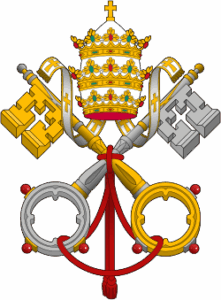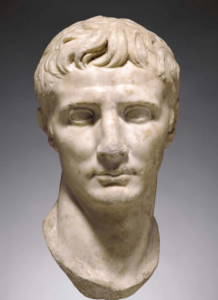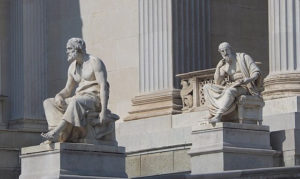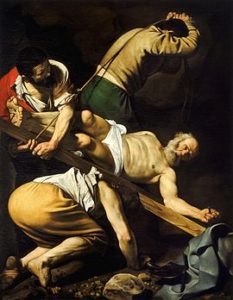– For the context of these translations click here –
Frankish bishops humiliate the emperor
The bishops strove to subjugate the state and in 829 in Paris, going back to the arrogant teachings of Pope Gelasius I, they demanded that no one could judge them, that they would be responsible only to God and that the other great ones, on the other hand, would be subject to them: the bishops. Indeed, their auctoritas was even above the potestas of the king and the emperor, who would otherwise become a tyrant and any moral right would disappear with his rule.
Their arrogance, sometimes clothed in the rhetoric of apparent modesty and false humility—the notorious sanctimonious hypocrisy—could hardly be greater. They praised, and rightly so, the humility of the emperors, because they always found humility in others very praiseworthy. But they always presented themselves as those on whom the Lord bestowed the power to bind and unbind, and recalled the supposed words of Emperor Constantine to the bishops (according to Rufinus’ ominous history of the Church): ‘God has made you priests and has given you the power to judge us also. Therefore we shall be rightly judged by you, whereas you cannot be judged by men.’
Too beautiful to be true.
The Empress Ermengarde had borne three sons to the sovereign: Lothair (795), Pippin (797) and Louis (806). When she died on 3 October 818 in Angers after about twenty years of marriage, it was feared that the pious widower would shut himself away in a monastery. And, naturally, for the clergy, it was preferable to have ‘a monastic mentality on the throne… rather than an emperor in monastic habit within the walls of a monastery’ (Luden).
The first uprising of 830 against the sovereign opened a decade of continuous palace rebellions and civil wars in the pious and family-friendly West. Understandably, the emperor’s eldest sons were irritated by the course of events. Especially Lothair, whose kingdom was seriously diminished in favour of Charles, and who saw his future supremacy in jeopardy. But also the younger couple of Pippin and Louis were threatened by another loss of territory. The ecclesiastical hierarchy, concerned about the unity of the empire, also feared its idea of unity.
Bernard, a descendant of the high Frankish nobility and son of William—Count of Toulouse, who was highly regarded under Charles I and who, on the advice of his friend Benedict of Aniane, became a monk of great asceticism—had little inclination for the Emperor’s tastes. It seems that he was much more attracted, according to especially episcopalian gossip, to the bed of the young empress. And Louis the Pious had protected the man from an early age, had him baptised at his baptism and later made him Count of Barcelona.
At the head of the conspiracy were former supporters of the emperor, some of his advisors, the then chancellor Elisachar, the arch-chancellor and abbot Hilduin of Saint-Denis, Bishop Jesse of Amiens and, above all, Abbot Wala, the spiritual leader of the uprising and Louis’ most dangerous enemy. He coined the slogan Pro principe contra principem and his monastery in Corbie became the de facto centre and headquarters (Weinrich) of the rebels. (Over the centuries, some Catholic monasteries became the headquarters of conspirators, as happened for example during the Second World War.)
The rebels wanted not only to drive away Bernard and the young empress and her entourage, but also the old emperor, and if possible to put Lothair in his place. After various tortures Judith, the second wife of Louis the Pious, was even threatened with death and a promise was extracted from her that she would force the emperor to have her hair tonsured and enter the monastery, and she had to shave her hair and go into seclusion among the nuns of the Holy Cross (Sainte-Croix) in Poitiers.
Lothair, who was viciously persecuting the supporters of the reclusive princess, avoided depriving her father of all power at the Imperial Diet of Compiégne (May 830). He contented himself with annulling his dispositions of the last year, or that he had the upper hand. But while the great men became more and more at odds with each other, each seeking his advantage, far from improving the situation distrust of the new government grew, and the emperor succeeded in setting his two younger sons against the elder. He offered Louis and Pippin an extension of their kingdoms, which quickly attracted them to his side and divided the allies, especially since the brothers felt that the supremacy of Lothair was no less oppressive than that of their father. For all these reasons the coup d’état failed.
Since Lothair was now confined to Italy, the emperor assigned in February 831 roughly equal kingdoms (regna) to his other sons Pippin, Louis and Charles.
But in early 833 the three elder brothers allied to attack their father with greater military force, trampling on their oaths of vassalage and filial duties. They appealed to the people ‘to establish a just government.’ For even Louis the Germanic (who had already risen again and again in 838 and 839) and Pippin of Aquitaine felt themselves to be under attack and threat. With a hastily mobilised army, Lothair marched into Burgundy together with Pope Gregory IV (827-844), who had tried to win over the Frankish clergy even from Italy. The archbishops of the region, Bernard of Vienne and Agobard of Lyon, immediately went over to his camp. The latter was the rabid enemy of the Jews, who now, disregarding also the fourth commandment, published a manifesto advocating the right of the children against the father.
Lothair re-joined his brothers and once again took the lead of the rebels.
As Louis was in danger of defeat, fewer and fewer prelates stood by his side. The pope mocked his haughty and foolish writings, and especially disputed the reproach which the imperialists had everywhere levelled at him, saying that he had become a mere instrument of the sons to launch the excommunication against their enemies.
The pope had to justify the uprising in the eyes of the masses and win over the rest of the wavering rebels to his side. Just after his return to the brothers’ camp almost the whole of Louis’ army (despite his additional oath of loyalty to fight against his sons as against the enemy) treacherously switched to the latter’s side ‘like an impetuous torrent,’ writes the Astronomer, ‘partly seduced by the gifts and partly terrified by the threats.’ The clergy on Lothair’s side recognised this as a divine miracle. And then almost all the bishops, who had previously threatened Gregory IV with deposition, also changed front so that the pope, who had fulfilled his obligation, was able to return to Rome with Lothair’s approval.
But the old emperor had to surrender unconditionally that summer. He was then regarded as overthrown by the hand of God, as a ‘non-king’, as a second Saul, and the bishops and others ‘did him much harm’, as Thegan puts it.
To begin with, Lothair had taken him through the Vosges, via Metz and Verdun, to Soissons, where Louis was imprisoned in the monastery of Saint-Médard. Prince Charles, who was barely ten years old, was taken from him and placed in the monastery of Prüm in the Eifel region under a severe prison regime as if he were a great criminal, as Charles would later say, although he was not made a monk. But the brothers of the empress were tonsured and sent to Aquitaine, Pippin’s territory, while she was immediately taken with Gregory to Italy and banished to Tortona.
With papal approval, the transfer of the empire from the hands of the old emperor—now designated by the bishops as ‘the old emperor’, ‘the venerable man’ and also ‘Lord Louis’—to those of Lothair was decreed.
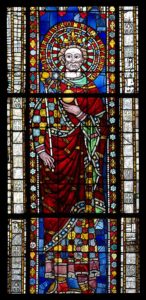
Stained glass depiction of
Lothair, Strasbourg Cathedral
For his part, Rabanus Maurus, abbot of Fulda and one of the champions of the unity of the empire, embraced the party of Louis the Pious and in a treatise dedicated to him wrote that it was ‘totally inadmissible for sons to rebel against their father and subjects against their sovereign’. Rabanus showed the injustice of the plot against Louis. Neither Lothair was authorised to dethrone his father, nor could the episcopate condemn and excommunicate him.
But how was Louis’ defeat interpreted by the prelates gathered at Compiègne, who with all the grandees had sworn an oath of loyalty to Lothair? The say him as a consequence, of course, of his disobedience to the exhortations of the priests. He had committed many evils against God and man and had brought his subjects to the brink of catastrophe. And so he was declared ‘tyrant,’ while his victorious son and successor was proclaimed ‘friend of Christ the Lord’. They, the ‘representatives of Christ,’ the ‘bearers of the keys of the kingdom of heaven,’ demanded from the old ruler a general confession of his sins: a renunciation of the world and presented him with a document of his crimes, so that ‘as in a mirror he might behold the abominable deeds’.
In his recent History of the Councils, Wilfried Hartmann observes: ‘Such procedures were only possible because the Frankish episcopate had already formulated certain theses in Paris in 829 which envisaged a kind of control of the political sovereign by the bishops.’ Thus, canon 55 proclaimed: ‘If someone governs with piety, justice and clemency, he is deservedly called a king; but those who govern in an impious, unjust and cruel manner are not called kings but tyrants.’ But whether a king is to be called just or unjust is naturally determined by… the prelates.
Louis must have been deeply humiliated at the Abbey of Saint-Médard de Soissons, where the prelates read him the card again, having to prostrate himself three or more times before the bishops and a multitude of other clerics, having to confess all that they had instilled in him with precise words—what is still called brainwashing today—and having to ask for their forgiveness.
To savour his wickedness, the hierarchs had staged this spectacle before the altar of the monastery’s St. Mary’s Church. In the presence of a large crowd of the people, they had the confession of his sins, which they had drawn up, read three or four times to the emperor ‘aloud and amidst a copious stream of tears,’ lying in a penitential garment of manes.
The whole process was, on the one hand, intended to morally annihilate the emperor and render him incapable of returning to the throne and even of bearing arms: canon law excluded him, as Louis knew very well, after a public canonical penance. On the other hand, the unbelievable degradation had to demonstrate the total superiority of the bishops.
It was 33 years since Charlemagne had judged Pope Leo III. Now the Frankish episcopate was judging the emperor! With the deplorable ceremony, the greatest opprobrium in Louis’ life and one of the deepest humiliations that any prince could have suffered, far worse than that of Canossa, Louis the Pious was also excluded from ecclesiastical communion and henceforth could only treat and speak with a few chosen persons.
Archbishop Otgar of Mainz acted as the jailer of the deposed Louis.
The leading role in this tragedy, which triggered a series of civil wars between 833 and 843, was played by Archbishop Ebon of Rheims, a close friend of Agobard of Lyons and a true prototype of ecclesiastical ingratitude and perfidy, as well as a man of notable missionary success. Years earlier, in fact, ‘on the advice of the emperor and with the authorisation of the pope, he left for the country of the Danes to preach the gospel, having converted and baptised many.’ This prelate, appointed by Pope Paschal I as the legate of the north in the framework of the Scandinavian policy of the Carolingians, is considered to be the initiator of the Nordic mission.
